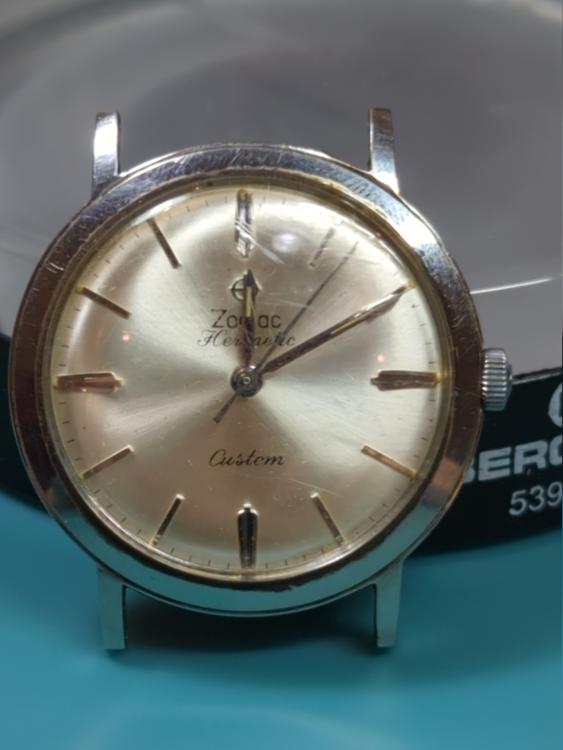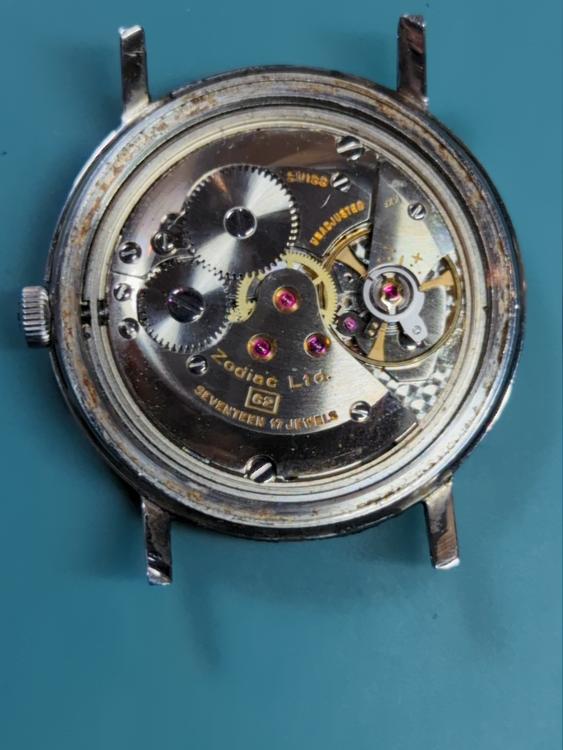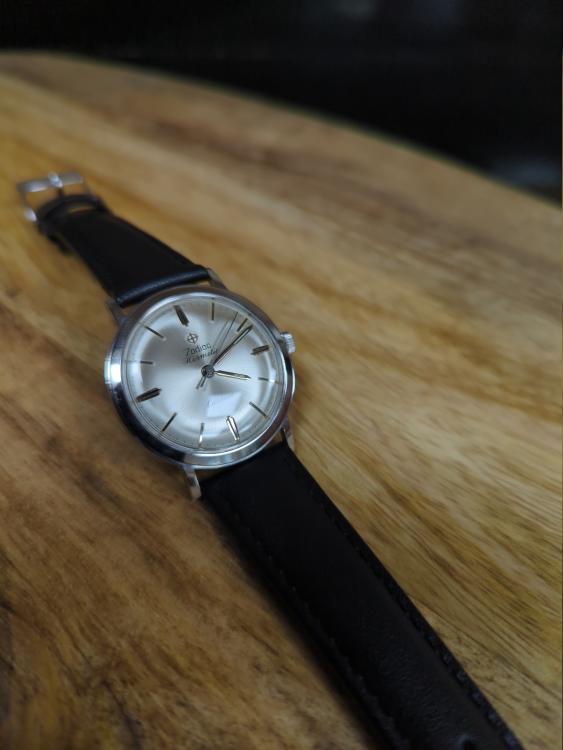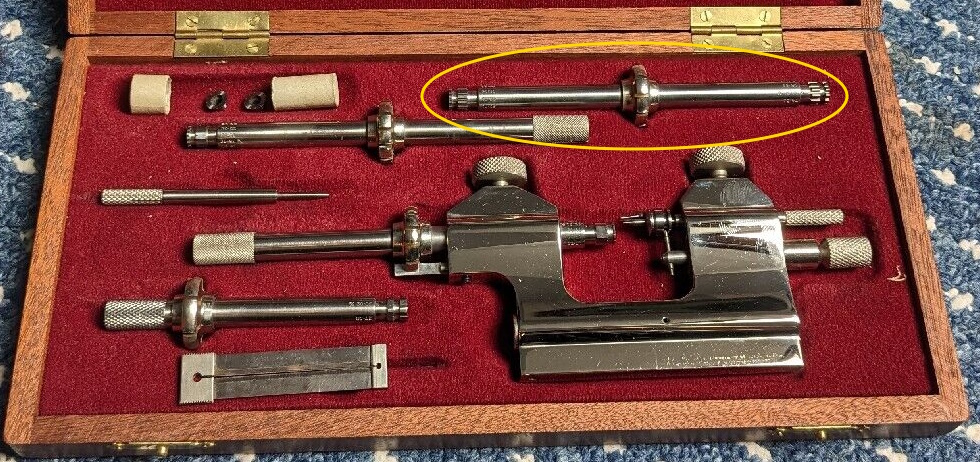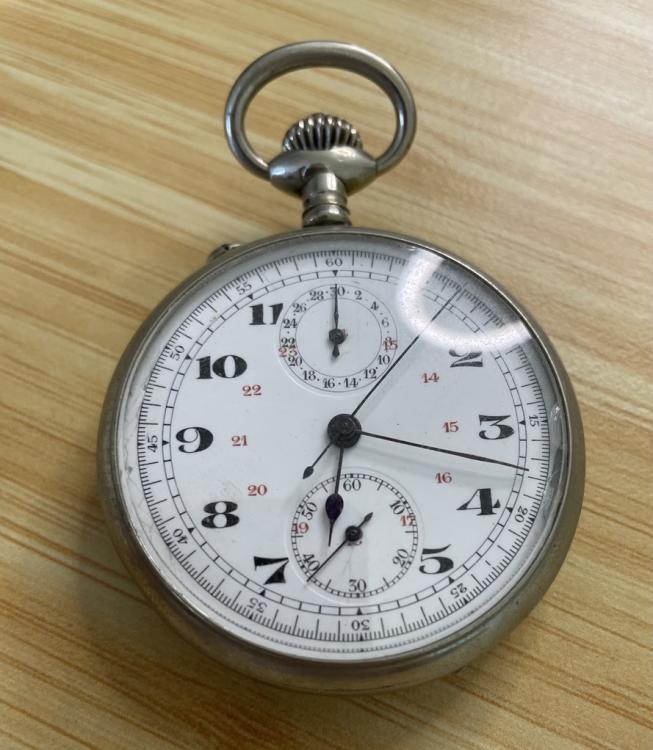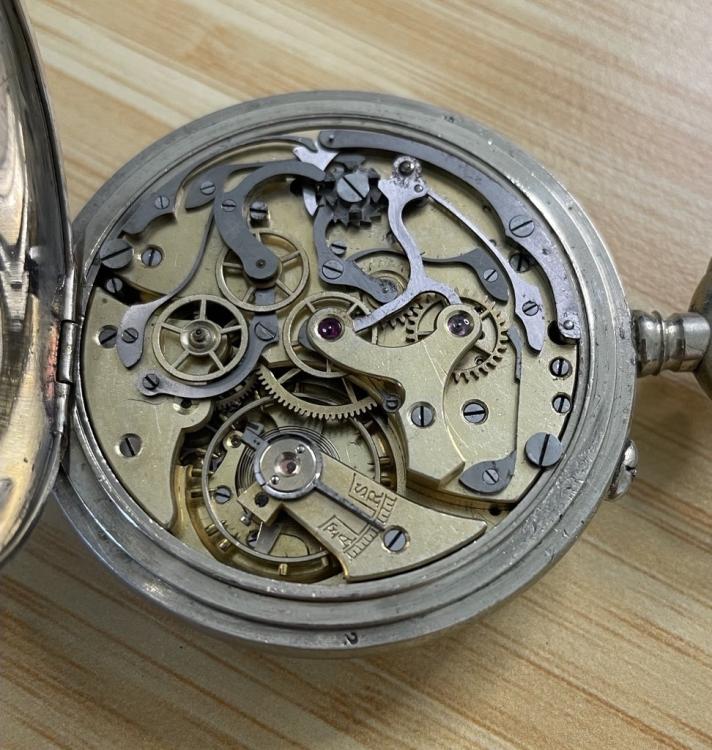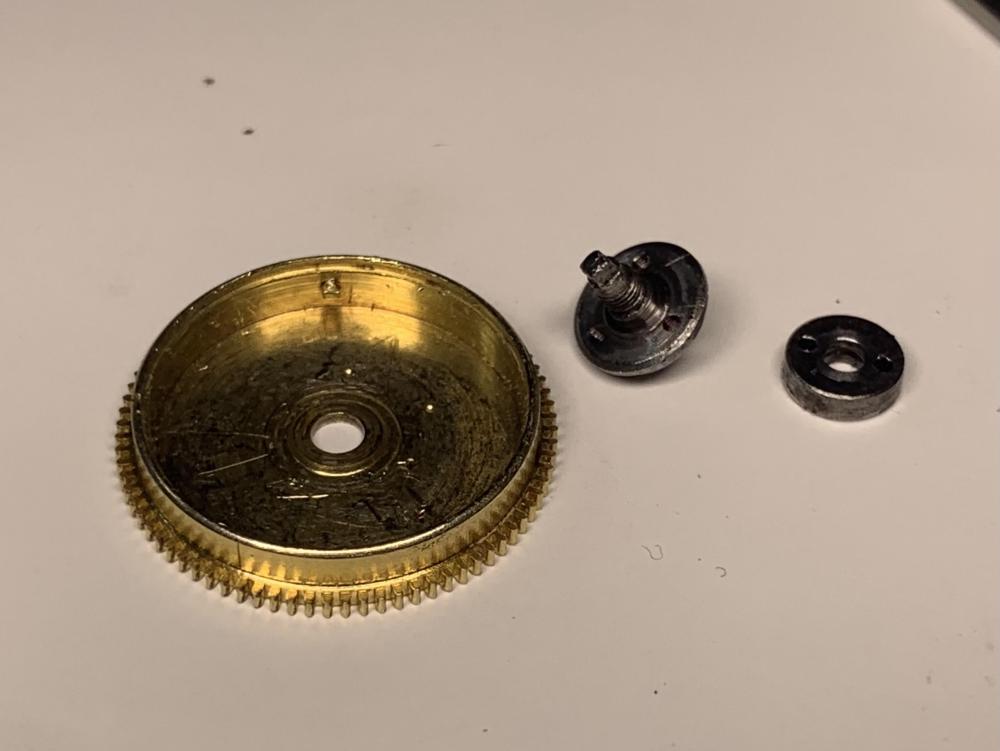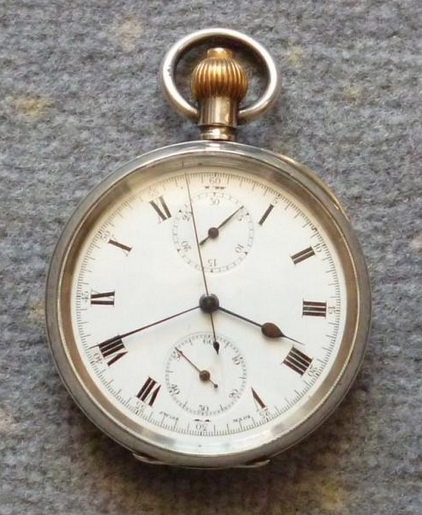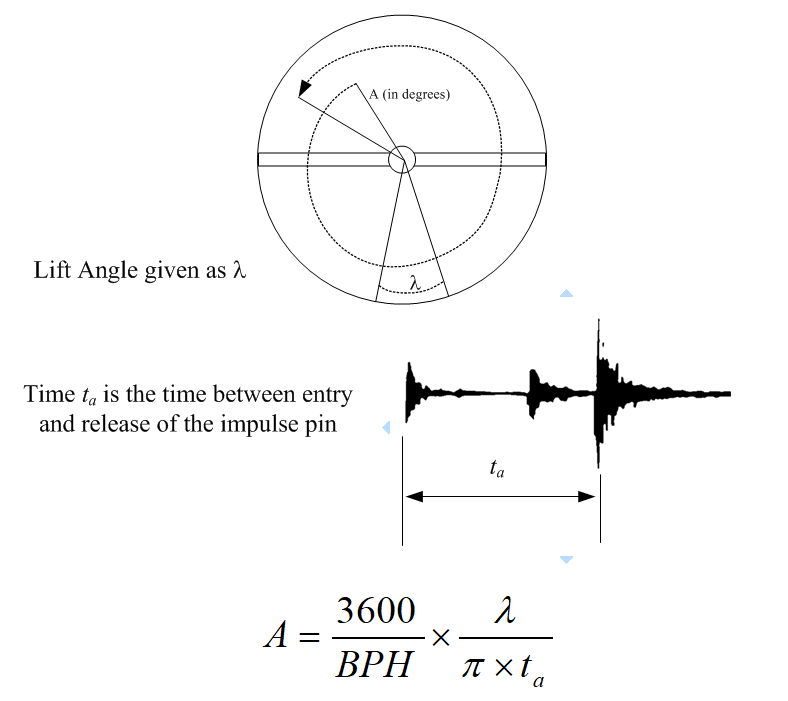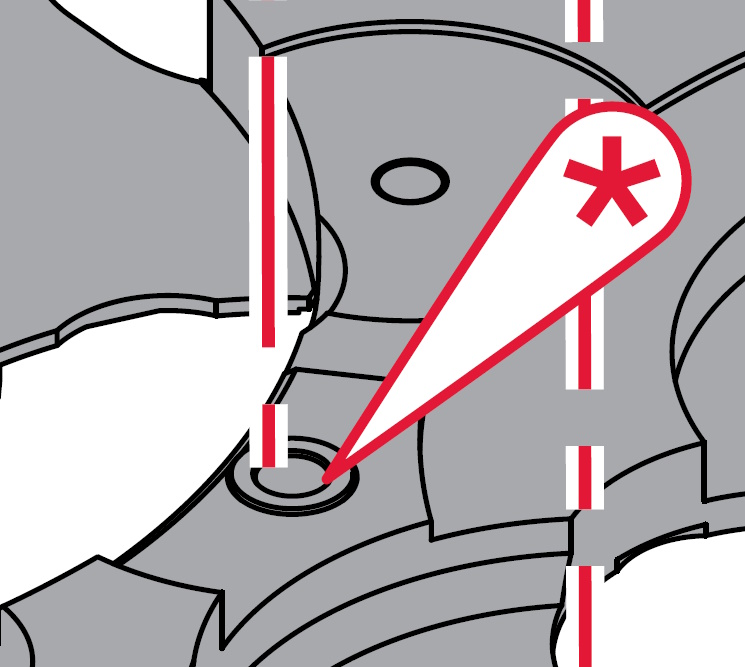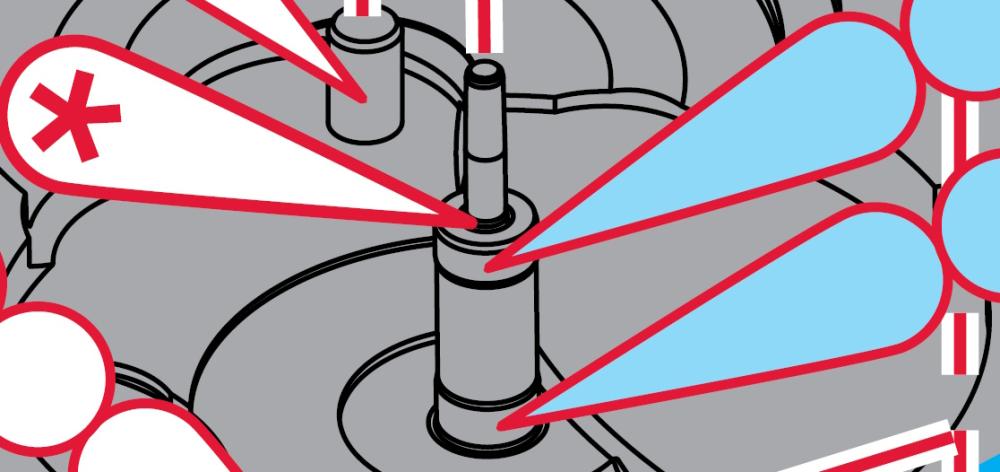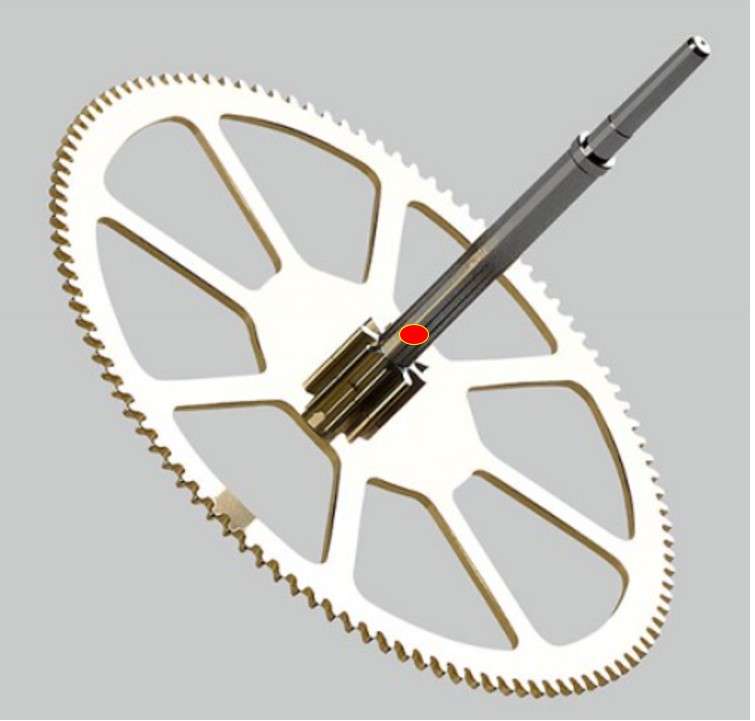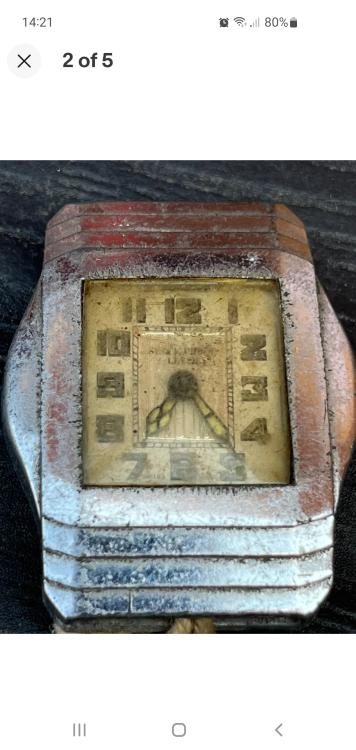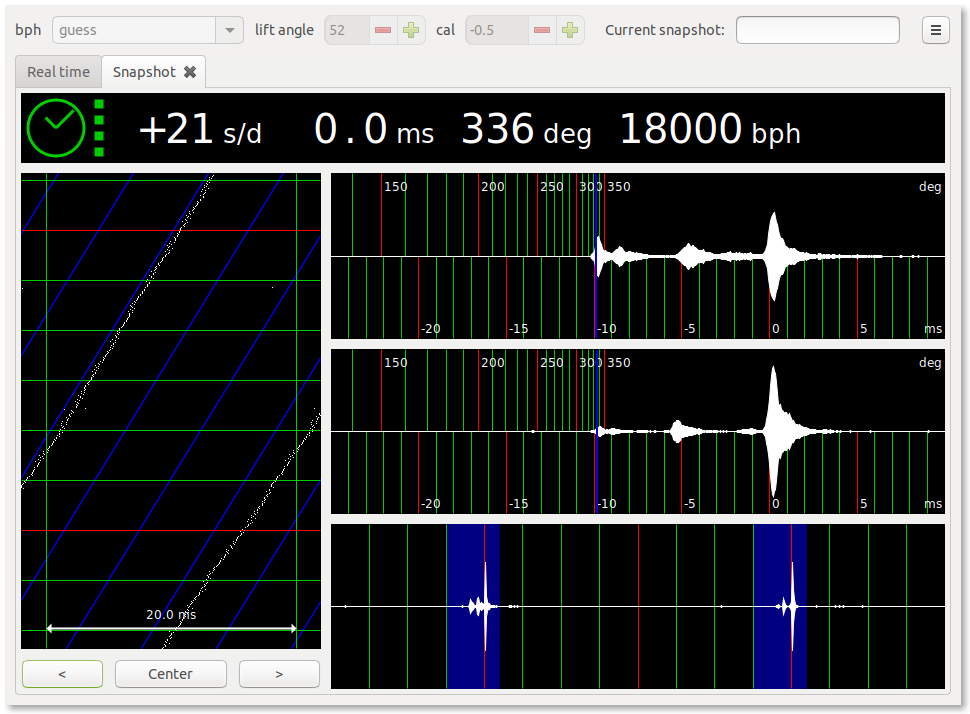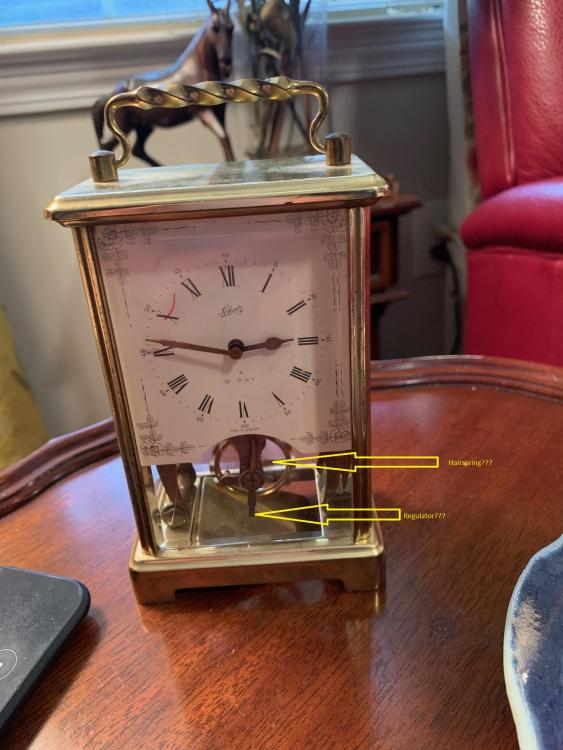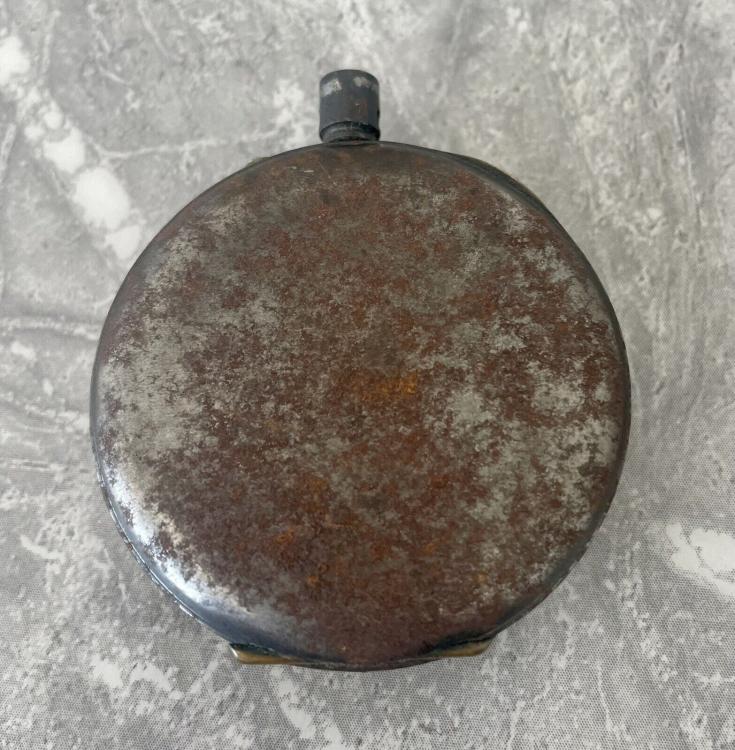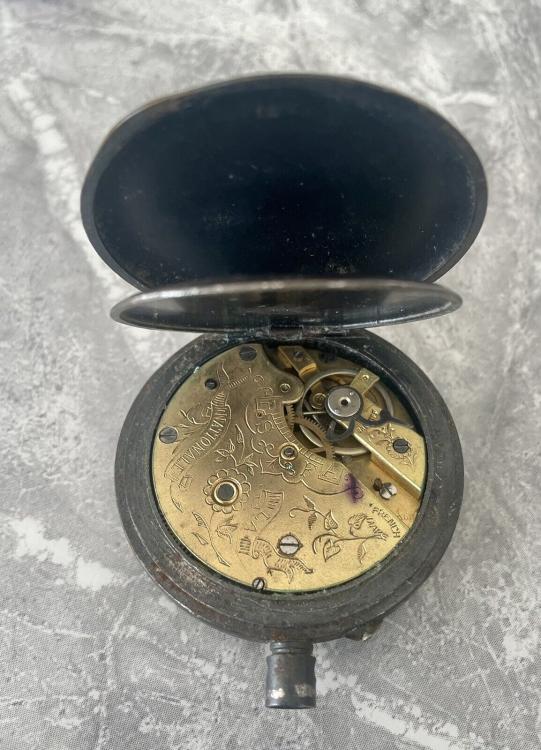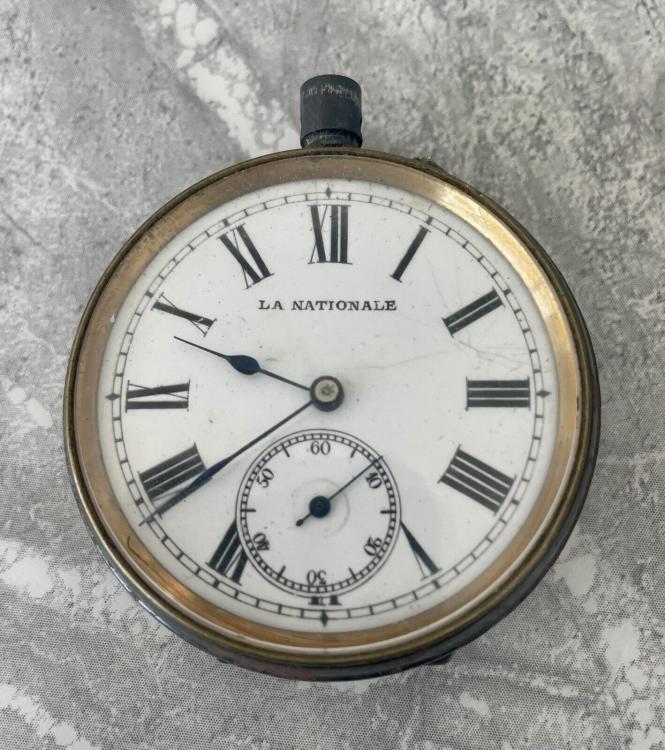Leaderboard
Popular Content
Showing content with the highest reputation on 05/27/23 in all areas
-
Here is my watch of today, It was a non-runner and I started about 7:30 am this morning and just finished around 4:00 pm my time. New crystal and strap, and re-lumed the hands, quite proud of this one a definite keeper! Before Front: And the movement, all in reasonable condition but LOTS of arm cheese on the case and sticky oils/grease inside: And the finished result (complete with fingerprints):8 points
-
Well, "Speak of the Devil and he shall appear". As I mentioned (somewhere) I've been on the lookout for a Steiner Jacot tool in good condition having a runner for centre wheels. Well, the wait is over. This "Zapfenrollierstuhl STEINER hochglanz vernickelt Bestzustand" (Jacot Tool STEINER high-gloss nickel-plated excellent condition) popped up on German eBay (not found if you just search for "Jacot tool"), and I was, to my great surprise, the only bidder and got it for £165/€190/$204 Usually, in this condition, they go for around $500, and there are "buy now listings" for $600-$700 and sometimes more.4 points
-
The seller from whom I bought the 1860-ish pocket watch (featured a few post back) had another interesting pocket-watch, which I decided to buy. I'm still working on the Le Phare 114CVV chronograph pocket-watch, but for €85, I didn't mind this similar looking, allegedly Valjoux (?), pocket watch. It seems in a little less condition than my Le Phare and the case is silver-plated instead of solid silver. It has a few (reset) flaws, but all is complete, seemingly original and in running condition. Another future project3 points
-
3 points
-
unlike the Friday afternoon cars that are forever troublesome. The last few rushed off the production line to get an early finish for the weekend lol.2 points
-
I would be happy to do it if he lived in the states. Once, someone on this forum sent me a 2824 that had the well known keyless works issue and I fixed it for him for free. I think he paid me for shipping...but maybe not. Currently, all of my work is for free...which is why I suddenly have so many new friends.2 points
-
The part circled in red is an additional headstock runner for the larger center pivots. It has a friction fit cap on one end (it's double ended). You can see the same friction fit cap on the one that's in the tool. Both runners have female cone centers to support the pivot. Tools without the center wheel runner (top right, double ended with support beds, no lanterns) will have only one headstock runner. The space above it is for the tube that holds spare lantern discs, which in the photo is there and is open showing the spare discs.2 points
-
2 points
-
1 point
-
I'm afraid I don't know but I believe you're right. Unfortunately, I can't remember how I interpreted the tech sheet when I assembled the movement, and so I don't remember how I oiled it. Anyway, I would think that a very small drop of 9010 on the 4th wheel pivot should be OK too. Here are a couple of pictures from ETA's technical documentation for the 2836-2 calibre:1 point
-
Very good question and it will be a bone of contention, as it is regarding lubrication. Personally, I don't lubricate the hole. If you were it would be just on the inside of the pipe. The reason I lubricate the fourth wheel rather than the hole is because, if the hole if lubricated with 9010, then most of the fourth wheel arbor will be coated with 9010 as it is pushed into position through the pipe. If the fourth wheel arbor is lubricated with 9010 like I've shown in the pic, then it won't do that. When fitting the wheel only the 9010 will reach the pipe when the correct part of the arbor does. Job done. You have to give the ETA schematic service manuals a big pinch of salt in my opinion. just look at how they get you to oil the cap jewels by putting 9010 on the chaton! Enough said... I'd be interested how that goes? I tend to use Moebius 8217, as I've had good results with brass, ali and steel barrels. Also what type of barrel are you using it with? Always good to learn a new way. Do you add the disulphide to the grease? If so, where do you get it from? I've heard it has really good properties needed in the barrel.1 point
-
usually things like that are power fluctuations through the gear train all the way back to the mainspring barrel. This is where it's nice to have a different timing machine where you ride time plot see if he could figure out which wheel is the problem if it's just one or everything. picking and choosing the best parts? the parts you rejected what were wrong with those? in other words I'm curious about quality control issues from the factory. then here's a link to somebody who showed servicing the watch and their timing results. Did a nice job of showing all the results I would've liked of seeing the graphical display though. Then it would've been nice to see it 24 hours later as to whether this watch is even running. But it does confirm that there probably quality control issues. Or perhaps there's the lack of quality control as long as the hands seem to rotate it leaves the factory https://17jewels.info/movements/w/wostok/wostok-2414a/1 point
-
Well, I didn't write that to please @Knebo. I wrote it because it is true. Each and every Vostok cal 24xx that I've serviced and measured has had a roller coaster-like graph. Sometimes more, and sometimes less. I've never seen a Vostok cal. 24xx with such a perfectly straight line on the TM. It could be me - although I hate to think it, and god knows I'm always putting my heart and soul into my work, sometimes perhaps too much - but it could also be that our comrades at the Chistopol watch factory had an unusually good day when they manufactured @Knebo's watch. Who knows!? I should mention that this phenomenon is less common after I've serviced Swiss and Japanese movements. If not, I would have given up, I think.1 point
-
Indeed, thanks! I didn't, but now I'm pretty sure I get it thanks to @nickelsilver. Thanks! I did notice, however, that it was very similar to the headstock runner in the tool so I thought that it could be a spare that had been thrown in from a different set without the seller's knowledge.1 point
-
Your regulator sounds like it might be damaged. There should be a small gap between the regulator for the hairspring to lie in. It should not be touching or pinching the hair spring at rest. When the regulator is moved left or right, the regulator should be able slide freely along the hairspring, thus the hairspring should not move at all.1 point
-
the timing machine is used for more than just fine tuning and adjusting it's a troubleshooting device. It is truly amazing how watchmakers survived before microscopes?1 point
-
1 point
-
1 point
-
1 point
-
You will find older calibres in Prague, look for the ones that have the same Prim logo as the one i posted. The two antique shops i mentioned will have something at a good price. They are a little way from where you are staying, maybe a couple of miles at most. I'm sure you will visit Wenceslas square and less than a mile or so from there. Give us a shout if you need direction. Enjoy your holiday Rich.1 point
-
Super cool! And amazing dial. Legible, sporty, precise.1 point
-
I bought it (with some other tools) from a retired watchmaker. I didnt know the the real purpose with these in the first. Now i cant work without these. One for pocketwatch arbors, and one for wristwatches.1 point
-
First off, I wanted to say thank you to a lot of you... I came here a few months back to learn more about how a watch works. I've always been interested in mechanical things, and have just loved watches. I find it absolutely amazing that something so small, can be jam packed with such precision items to do what it does. I know I have asked a ton of questions from many of you, and you all have been absolutely patient with me. I'd love to give a shout out to all of you, but I know I would forget someone and I don't want to do that, so thank you all! One of the things I have always liked are books. In order to learn something, it helps to be able to read about it from those who are far more knowledgeable than I am. Granted, just reading something won't make you an expert at doing it, and that is where practice comes in. But you still need to have a good understanding of what goes into it. I know I have reached out to a number of you about books or images that you may have shared with all of us. I think I have a good little library now that I can use to reference. I think I asked @JohnR725about if one book is better than the other and his answer was something along the lines of not one book is perfect, but they all add something. Anyhow, I'd like to share with those who may be new to this hobby some of the books I have picked up and some of my thoughts on them. If possible, I will provide a link to Archive.org so you can see the book. Not all of them are there though, but all of them I physically own, which is how I generally use them. The first book I got was The Watch Repairer's Manual by H.B. Fried. I found an older version of this book (2nd edition) on a used book site for hardly anything. Granted, it was written some time ago, but I have found it to be a good combination of somewhat modern and old. It has some great information on the escapement, the pallet jewels, etc that I have been referencing. The next book I got was Practical Watch Repairing by Donald de Carle. Mine was from 1946, so I'm not exactly sure the edition that is, but I really like this. Mr de Carle doesn't assume I know much and explains things very well. This one I find a bit more readable than Fried's, in that I feel like I could easily read it from the start of the book and not just use it as a reference book. I'm not sure how practical doing that would be, but I'm going to give it a try. I find that it supplements Fried's book well. Some things are very similar, but the two books cover more grounds together than they do individually (as can be said for all the books in my library I think). The next book I just got today, and that is The Swiss Watch Repairer's Manual by H. Jendritzki. I wasn't able to find find this one online for reference first, but I did find a good price for one from 1953. The link I have just takes you to OpenLibrary so you can get all the technical detail on the book. I just happened to luck out and find this one for a steal ($40 + shipping), so you may have to search for this one. I think EBay had this for some insane prices, but if you look at the sold items for it, you will see that it does come up from time to time at a reasonable price. Biblio and AbeBooks are also great resources to find one, the former is what I used. Being that I just got this book today, I have not had much of a chance to look at it yet. It seems very good, lots of pictures and details, but time will tell. It does have a nice table of contents, and also some excellent charts in the back but no index (both previous books had an index) The last book I have currently in my library I have some mixed feelings on. I think it is a great reference book, but it is expensive. It is titled The Theory of Horology and is part of the Watchmakers of Switzerland training and educational program (WOSTEP). In short, it IS a textbook. It is very technical, and it may be way overkill for a hobbyist. It was expensive, I found mine used, but I paid $90 + shipping for it from Biblio. I saw it for a lot more than what I paid though. The one item that I don't like about the book is that the table of contents are near the back, and there is not an index. I get that it is a textbook more suited for a technical schooling, but I find it a disservice to those who use it to not have an index. I do feel this has some excellent diagrams, and some very technical documentation, but much of that may just go unused for the hobbyist like myself. At my age and state in my career, I don't see myself going away to watchmaking school, so I just look at this as an investment and someday, it will pay for itself. Well, that's it for now. Does someone who is new to the hobby need all of these books, absolutely not. I have a library in my home and always encouraged my kids to read whatever they can get their hands on, so for me, this is a good first step for me. Will I invest in more books on the subject, I'm sure I will and if you have any books that you think I should check out, please let me know.1 point
-
With a bit of TLC and a thorough cleaning, it runs surprisingly well. I can't guarantee the lift angle is correct, and those minor deviations in the trace were caused by me coughing. I also added a small dial dot, as somehow one of the dial feet was missing the bottom third or so and the screw wouldn't catch. This was causing the dial to sit squint and pop up to touch the hands. I'm not sure if this is how it left the factory, but it is corrected now and everything is running smoothly. I'll finish the regulation tomorrow once it has had a chance to settle down, but I think it is a pretty worthy addition to the 404 club I've popped it on a burgundy leather strap and am wearing it as I type this. Time for bed now I think.1 point
-
It's a nice setup you have... certainly takes up far less real estate than the base with an arm. Granted, I could always get the other Amscope mount (articulating arm) but that would cost quite a bit more than this and I don't know if you would be able to tilt the head.1 point
-
1 point
-
Anchor brand belongs to Cambridge time spares in Mumbai. They are wholesalers and supply Cousins and others. I bought from them many years ago, shipping was costly then. Maybe they sell to end users today, an email request may show. CTS is one of the serious sellers who look (a bit) on quality. But eventually they are merchants, no watchmakers. Frank1 point
-
A slightly scruffy "La National" French cylinder pocket watch, with a nicely decorated main plate, is on its way. Its missing its crown, stem and bow, but otherwise looks complete. Hopefully with a little care and a clean and service, it should run. I probably have something suitable to replace the missing parts with. It came in 14 pence over the 404 club budget, but with inflation the way it is today, I think we may bend the rules and allow it in to the club.1 point
-
Thanks for this. Taboo as the subject is, I am inching toward a frankenwatch project involving a 2nd hand 2836-2 movement. I acquired a NOS case and dial of a Helvetia President watch. The hands are pretty standard fare. The 2836-2 and cousins seem to be dimensionally compatible with the case and i can design and 3d print my own spacer if needed, and the 2836-2 is superior to the original movement so as frankenwatches go, considering i rarely sell anything and would never sell this project without extensive documentation, i figure it is not too egregious. The 2836-2 bears dial and hands and rotor from a Wenger ("Swiss Military") watch and my timegrapher confirms that it is a 28800bph movement and running strong so i have doubts that it could be fake. It is certainly a loose movement that is at least 5 years old so some service is in order. I have 9010, D5, and 9415. I will probably use Nye PML Stem Grease on the winding components because i have it and it is excellent. I have 8302 natural grease with disulfide and i am under the impression that it is an acceptable braking grease if not as ideal as a couple other moebius products. Remains to be seen if i can be talked into Lubeta v105 as well. It could happen. It could also happen that i might just put on the 10x loupe and put a dab of something on several spots of the reversing wheels. I'll read through this at least a couple more times before i dive in.1 point
-
0 points
-
0 points





